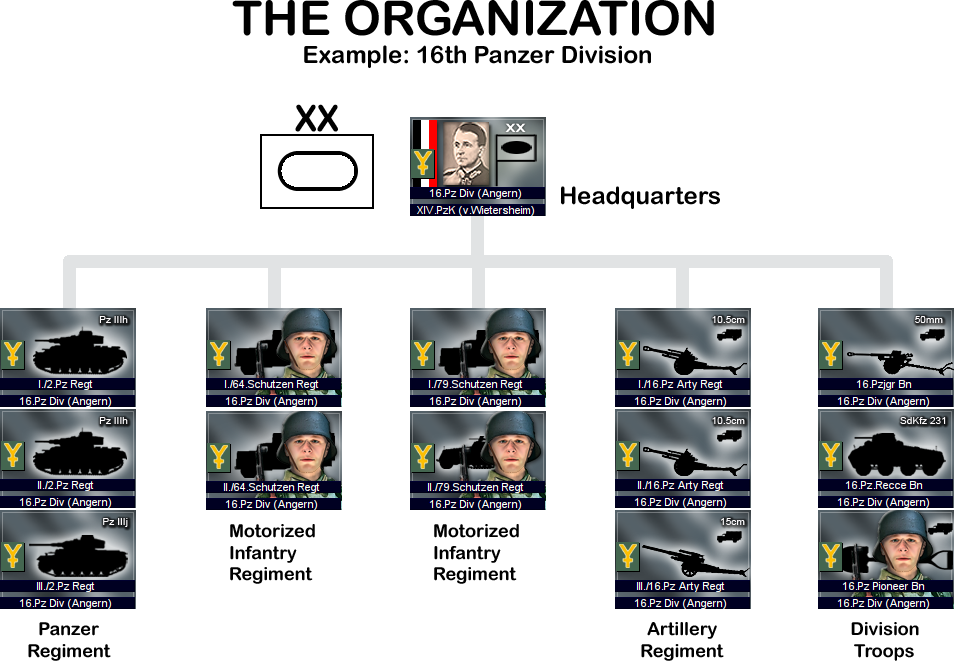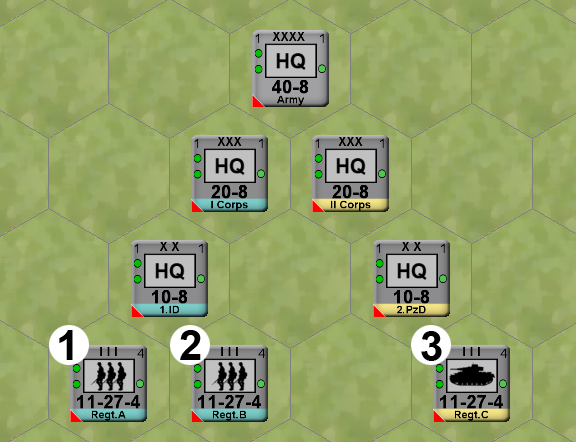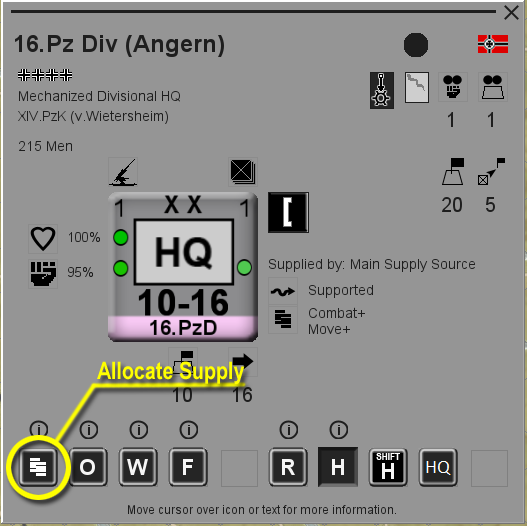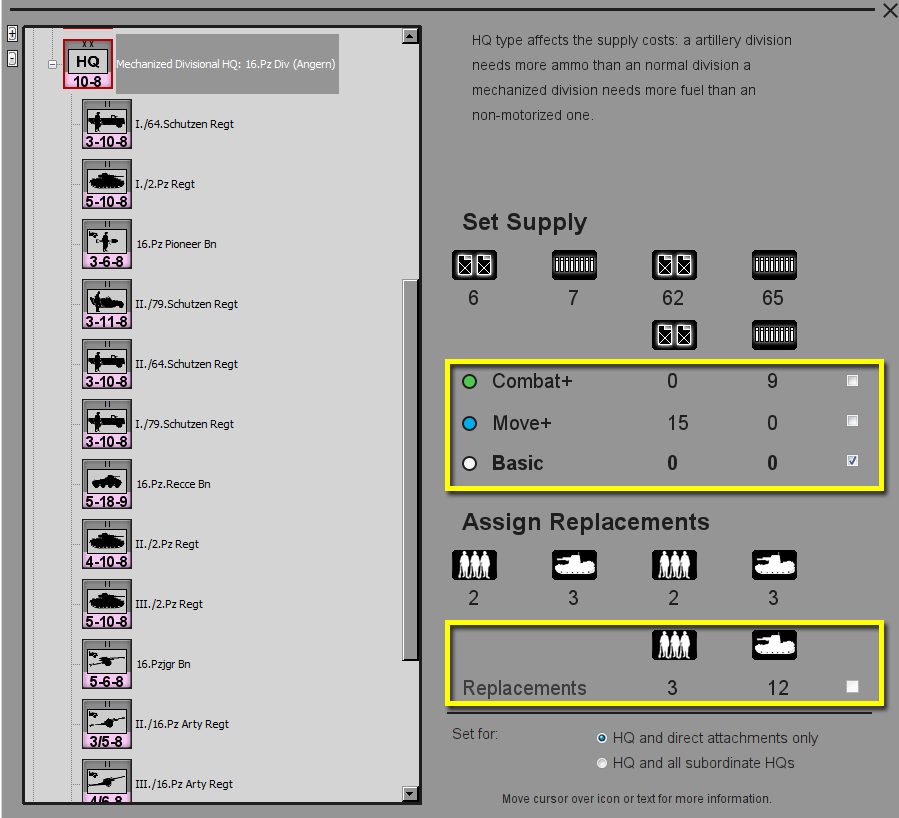“The only difference between a mob and a trained army is organization.” – Calvin Coolidge
During the Second World War, levels of command from army group down to the battalion were given a unique piece of ground in which to operate, a mission, and command of specific units to accomplish the task at hand. This “unity of command” made a single commander responsible for the planning, coordination and deconfliction of operations within his defensive sector or zone of attack; staying “between the lines” on a map. Incorporating this type of control mechanism in a wargame is a challenge and may be too tedious a constraint for the casual gamer. In designing WEGO WWII: Stalingrad, we wanted to represent the effects of unity of command without the restrictive control measures. We think we’ve accomplished this through—The Organization.
ORGANIZATIONS
So what makes an organization? Simply put an organization is a headquarters unit (HQ) with one or more subordinate units assigned to it. Army, corps, and brigades are all examples of organizations. The most prevalent in the game is the division. The illustration below is an example of a division. We see that the HQ of 16th Panzer Division has 13 subordinate battalion-sized units assigned to it. Note that there are no regimental HQs; the higher HQs (HHQ) for all 13 units is the division HQ.

Whenever the subordinate ground units of an organization attack or defend together they are said to have Organizational Integrity.
ORGANIZATIONAL INTEGRITY
This concept reflects the difficulties experienced while attempting to execute/coordinate large combined arms operations—especially those involving units from other organizations. An attack or defense by ground units with organizational integrity minimizes the penalties on friendly and enemy attack and defense values. National armies have different levels of training, combat experience, and command flexibility/initiative so the exact penalty suffered depends on the Nation involved. The tables below illustrate the penalties each Nation will experience.

* Minor Allies Nations: Croat
We can see from the second column that units attacking or defending alone are not impacted by organizational integrity. After all, they are just a single unit. However, we start to see significant degradation of combat power the further we get from the same HHQ. The number of HQs "jumps" required to find a common HHQ for all units involved in an attack or defense is used to determine which penalty is used.
For example, in the image below we see five organizations—one Army-level, two Corps-level, and two division level organizations. There are also three subordinate units. Two regiments belong to the 1st Infantry Division (1.ID) and one belongs to the 2nd Panzer Division (2.PzD).

The two infantry regiments (units 1 & 2) are German and share the same HHQ. Their combined attack value if they attacked together is 22 ((11 + 11) x 100%)). If they defend together (in the same hex) their defense value is 62 ((27 + 27) x 115%)).
If the two infantry regiments were joined in an attack by the panzer regiment (unit 3), then it takes two “jumps” from the 1.ID HQ to get to a common HHQ. In this case, it is the army HHQ. Therefore, the combined attack value would be 26 ((11 + 11 + 11) x 80%). That’s a net loss of seven attack points. From this illustration we can see that “piling on” with several organizations isn’t always a good idea.
LINES OF COMMUNICATIONS
Lines of Communications (LOC) start at a Supply Source and are tracked down through the levels of command from the “Supreme Headquarters” to the organization’s HQ. For combat units to be in normal supply they must be within the movement point range of their HHQ.
The LOC range of an organization’s HQ is the number of movement points it has for distributing supplies. These HQ LOC ranges are generally limited in length depending on the echelon of command:
Keeping an organization together—within LOC range—is critical to maximizing its performance while moving, attacking, and defending.
SUPPLY ALLOCATION
Supplies are not allocated to individual units; they are allocated to organizations. The player can change the supply levels of an organization by right clicking on any unit in the organization and then selecting the Supply button on the bottom left side of the unit’s pop-up window. This will bring up the HQs Supply Display.

The player can then select the check-boxes next to the desired supply levels. There are three Supply Levels: Basic, Move Plus, and Combat Plus.

Each organization will always be at one or more of these levels—the default level is the Basic Supply Level. An organization can be in Move+ and Combat+ at the same time. In addition, an organization can increase the strength of each of it units by 10% if there are sufficient replacement points available. At the end of every Execution Phase, the supply levels for all organizations will revert to the Basic Supply Level automatically.
Understanding organizations and how to employ them in WEGO WWII: Stalingrad is the key to victory. Peak performance in combat, clean lines of communication, and the best use of assigned supplies—all are tied to proper management of the organization. So build your plans around organizations—not individual units heading every which way but loose. Stay together and hold the line!











